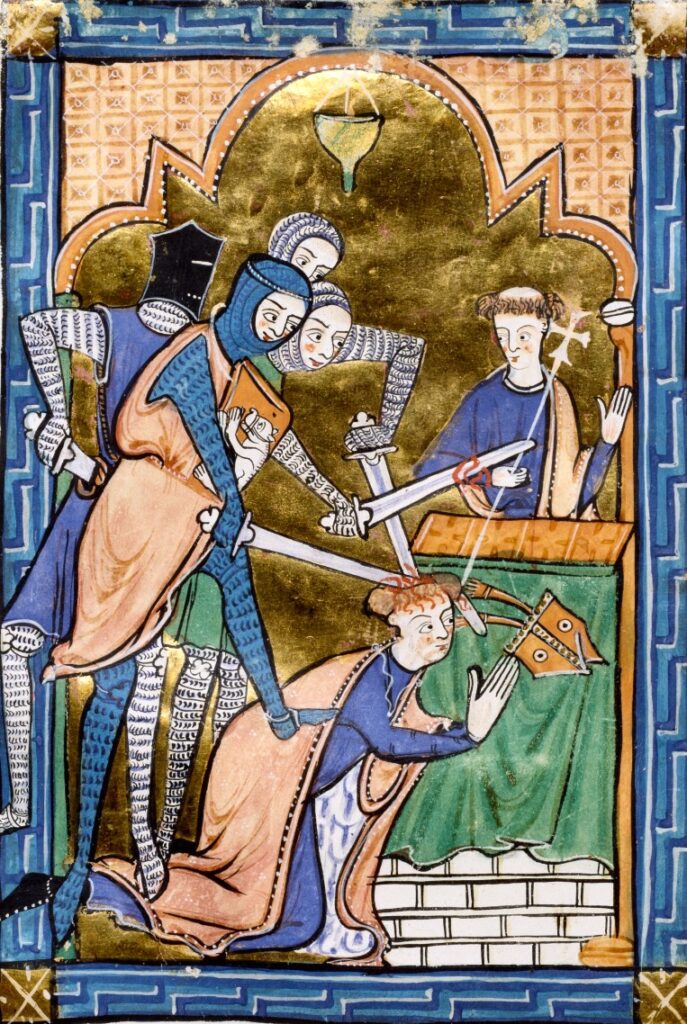We lose count, on the Fifth Day of Christmas, but it is the commemoration of perhaps our greatest English-speaking martyr.
“For the name of Jesus and the protection of the Church, I embrace death.”
This was said by Thomas Becket, prior to having his brains splashed on the floor at Canterbury Cathedral, on the 29th of December, 1170. This was done by four knights, who believed they were acting on the instructions of Thomas’s childhood friend, Henry Plantagenet, then Henry II of England.
Arrogant as he was by nature, according to contemporary courtiers and most liberal historians, he chose death as a martyr does; rather than the alternative of infamy – in light of his position, from where he could see Christ.
Miraculously, in that age prior to social media, Becket was hailed as a martyr right across Europe – almost instantly.
His shrine in England was the most splendid. Henry II did not stand in the way, and indeed he went to Canterbury to do penance for “misspeaking himself” in such a way as to inspire murder.
He was a cold warrior and an empire builder (from the flesh of France, Scotland, Ireland, Wales), whose reputation among the historians has been generally favorable. He does better than Thomas Becket, perhaps, who has suffered at the hands of intellectuals through the last five centuries.
For in the old conflict of Church and State, historians are generally on the Statist side, where they can discern progress.
This was in the roots beneath Thomas Becket. He stood in the way of Henry II’s reforms, defending the mediaeval status quo of Catholic independence, rights, and privileges.
The “Constitutions of Clarendon,” promulgated from King Henry’s hunting lodge in Wiltshire, continue to be “obscurely relevant” today, for they propose to deal with an issue that does not go away, so long as Christianity remains legal.
They established the principle of the priority of the State, in law. This conflict continues, even in a time when very modern errant priests, charged with things like sex crimes, are called before ecclesiastical courts – where they are reminded of their vows of obedience. They will be judged not by their peers, but by their superiors.
Put before the boss, as it were. The alleged felon might expect more lenient treatment than would be likely in a “secular” court. The general public, in the XIIth century as now, will have opinions about this. Opposition to the Church on these grounds can be politically remunerative; for “criminous clerks” claiming “benefit of clergy” have been, since ancient times, not a good look.
The people, and the people’s king, want something harsher than the flogging, fines, demotion or at worst defrocking and excommunication that were available to the ecclesiastical authorities. The common law could, after all, sentence a man to death almost whimsically, leaving his victims and their friends deeply satisfied.
And while kings ruled, and made their wishes clear, the requirement for evidence was not oppressively strict. Nevertheless, in the Middle Ages, senior clerics were not judicially murdered. It wasn’t done.

King Henry’s medieval compromise was to let the priestly malefactor first be degraded by an ecclesiastical court, and then the common law would get hold of him. Thomas Becket, on the side of the Church but with secular cunning, argued that it was wrong to punish a man for the same offense, twice.
We fall back on Melchizedek, the authority on the height of priests. Christ Himself is of the order of Melchizedek. His apostles, even Judas (high-ranking in Aaron’s line), cannot be hired and fired as they do in big companies.
I recently went to the wall myself, in defense of a certain pope. We may not like him, I said, and we may have reasons for not liking him, but his installation was valid. Only God is in a position to abrogate his appointment. Should God not intervene, he is pope forever.
Becket, to be sure, knew both sides. Like England’s other great Thomas, Thomas More, Becket had been the chancellor. They were also fellow Londoners (Becket born at Cheapside, More in Milk Lane). They were ornaments of the State, and the later Thomas nothing more in his lifetime.
But Thomas Becket presents an especially rare case, in human psychology. In early life his reputation was that of a somewhat reckless and headstrong son of a rich property owner, who later went bankrupt. But Thomas did not lose his willfulness. Off to Paris in his youth, he was an undistinguished student; his Latin was appalling. I imagine him as a rather loutish young man.
But on his appointment as Archbishop of Canterbury, he was, as seemingly everyone noted at the time, transformed – into a modest, thoughtful, holy man, characteristically deep in prayer. This happens, sometimes.
The story of Becket’s martyrdom is, to my mind, no longer quite accessible to his Anglo-American successors in the Roman and Anglican communions. The details of his murder were made quite plain, by such ideal witnesses as Edward Grim. Yet the medieval background and political horseplay are, strangely enough, too much like the present to be easily understood.
In particular, how did people in their masses know that Thomas Becket was an illustrious martyr? And how, for more than three centuries after Becket’s death, did Canterbury become one of Europe’s primary destinations of pilgrimage?
Note, this was the cathedral of Canterbury, built inside a monastery, and endowed with chantry and formal shrine. It wasn’t to the seat of the English church that pilgrims “from every shires ende / Of Engelonde to Caunterbury they wende, / The hooly blissful martyr for to seke.”
This mystical Canterbury was an institution brought crashing down by the devil, Henry VIII, who did what was in his power to cancel it. (Protestantism was the pioneering “cancel culture.”)
What had been a Mystery (for the late Becket was credited with many wonderful cures), was then reduced to a controversy.















